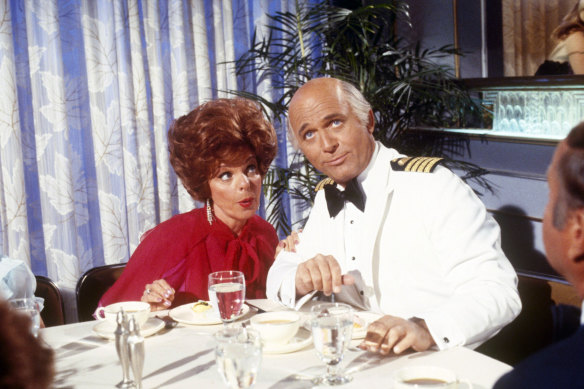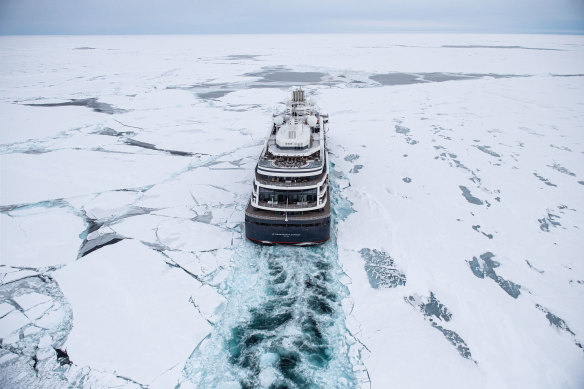This was published 1 year ago
Opinion
What it’s like to dine at the captain’s table on a ship
Lee Tulloch
Travel columnistOn a cruise, it’s quite a privilege to be invited to dinner at the Captain’s Table.
Not all guests get the opportunity. It’s often reserved for loyal customers of the cruise line and those in the more expensive suites. The smaller ships try to rotate the guest list so that as many passengers as possible have an invitation during the cruise.

Captain Stubing mixed with all sorts at the Captain’s Table on the classic TV series The Love Boat.Credit: Getty Images
These dinners are formal, and conversations tend to be on the conservative side, mostly chit-chat about all the cruises the other well-heeled and well-travelled dining companions have taken.
What I enjoy most about the Captain’s Table is the chance to sit next to an actual captain.
Ship’s captains are curious creatures. Often married, they spend long months away from their families. While they need exceptional technical knowledge and judgement to command a billion-dollar vessel, they also need superior personal skills to manage crews of hundreds of people and sometimes thousands of passengers.
They’re responsible for all these lives.
I often wonder what the captains think of the Captain’s Table. He or she (overwhelmingly a man, as only about 2 per cent are women) can be unfailingly gracious, despite the fact they are obliged to do this often. Some captains are naturally gregarious, but others would clearly rather be back on the bridge.
I’ve asked, but I always get a suitably diplomatic answer.
A few months ago, I was invited to the Captain’s Table on Le Commandant Charcot, Ponant’s luxury icebreaker and polar expedition ship. The ship was in port at Lyttelton, New Zealand, and about to depart for a month-long journey to Antarctica.
I wasn’t going with it, unfortunately. But I was there for dinner, and I found myself seated next to Captain Stanislas Devorsine while tucking into a multi-course meal by Alain Ducasse (who oversees the menus from afar).
Captain Devorsine, although from the south of France, tells me he spent many years in Hobart, working on icebreakers with the Antarctic Division and other companies, and he’d been brought aboard Le Commandant Charcot for his expertise in ice.
The ship is a cocoon of cream and sea-blue luxury, the cashmere of cruising. A 28-day Antarctic voyage might set you back over $65,000. It’s not a hardship posting.

Le Commandant Charcot moving through the ice.
Billed as the world’s first luxury icebreaker, the ship’s technology is “mindblowing,” according to its captain, who has sailed on six icebreakers in his career. Powered by electric hybrid natural gas, it’s the only icebreaker to have stabilisers installed in its hulls, so the ride across rough waters should be smoother.
But, as impressive as the ship is, I was really interested in only one thing. How dangerous is polar cruising. Really? I had my chance to ask the man at the ice face.
Captain Devorsine did not disabuse me of the dangers. He’s still awed by the ice walls, which can reach 50 metres high. The ice has different thicknesses, strength and flexibility, he told me, so it’s critical to have expert knowledge of how it behaves, even with all the technologies such as satellite and helicopter tracking. Navigating it sounds extremely stressful.
He reassures me that if disaster strikes, all central systems are doubled on his ship – two bridges, two hospitals, two different power storage systems – to allow it to return to port. Lifeboats have heaters, toilets and supplies for days.
As well, the ship has an ice survival camp that can be deployed on water or land. Post-apocalyptic-looking polar immersion suits issued to guests can be temporary shelters in themselves. Everyone needs to try on the suits before the voyage starts, which introduces the seriousness of the expedition up front.
The inside intel from the Captain’s Table is that polar expeditions these days are more comfortable and safer than ever, and there are increasing numbers of voyages, but the ice still deserves a healthy respect.
Lee Tulloch was a guest of Ponant. See au.ponant.com
Sign up for the Traveller Deals newsletter
Get exclusive travel deals delivered straight to your inbox. Sign up now.